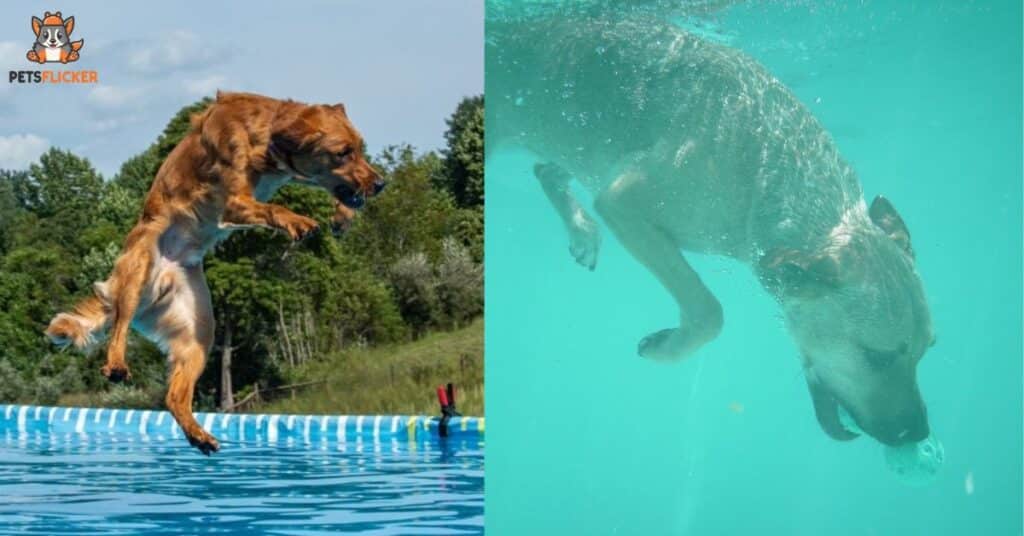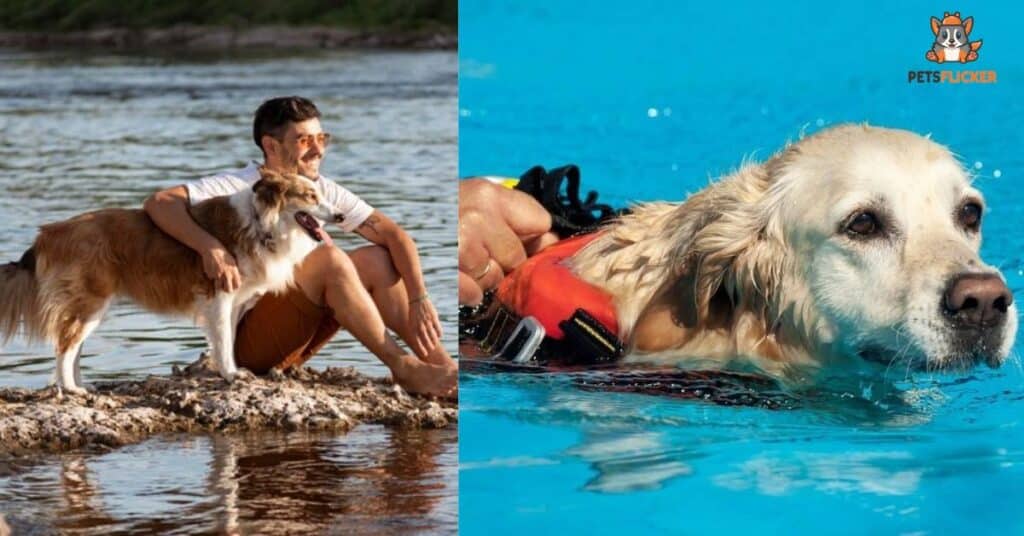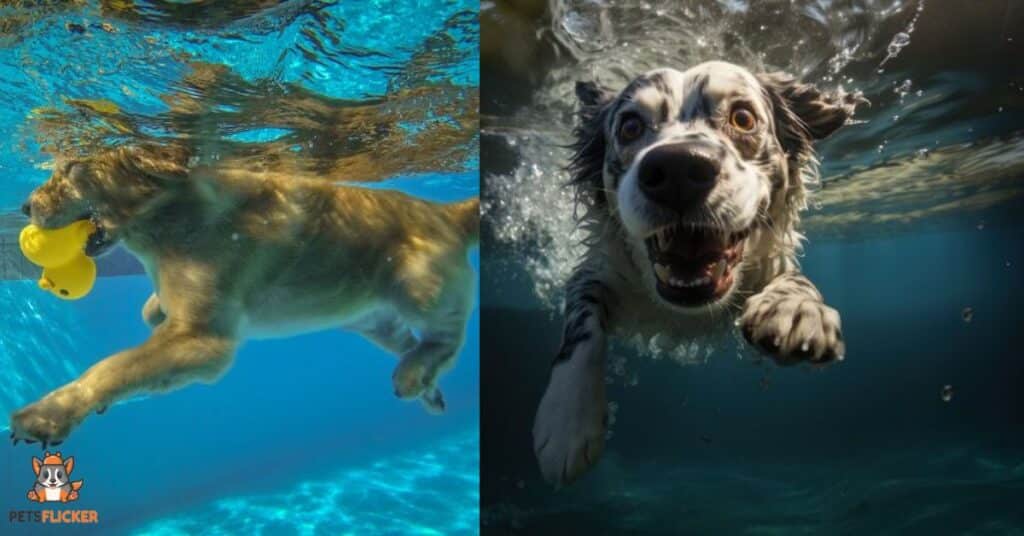Dogs have a special ability to hold their breath underwater. When they dive, their bodies naturally slow down their heartbeat and conserve oxygen. This helps them stay underwater for a short time, usually around 5 to 8 seconds.
But how long a dog can hold its breath depends on factors like breed and size. Dogs with longer snouts might hold their breath a bit longer than those with shorter noses. It’s important for owners to supervise their dogs around water and make sure they stay safe during swimming adventures.
5-8 Seconds
Dogs can hold their breath underwater for a short time, typically ranging from 5 to 8 seconds. This ability is thanks to their natural physiological responses, which kick in when they submerge.
During underwater exploration, dogs slow down their breathing and divert blood away from non-essential organs to conserve oxygen. However, the duration of breath-holding can vary based on factors such as breed, size, and age.
How Deep Will a Dog Dive?

Dogs typically don’t dive very deep underwater, usually only a few feet at most. Their diving depth can vary based on factors like breed, size, and comfort level in the water. Small breeds might only go a couple of feet deep, while larger breeds might dive a bit deeper, up to around 5 to 7 feet.
It’s essential to supervise dogs when they’re swimming to ensure they don’t go too deep and encounter difficulties resurfacing. Dogs aren’t naturally adapted to deep diving like some aquatic animals, so it’s crucial to keep an eye on them to prevent accidents.
Always provide a safe environment for your dog to swim in and be cautious of water depths to keep your furry friend happy and healthy. Can You Teach a Dog to Hold Its Breath?
Can You Teach a Dog to Swim?
Yes, you can teach a dog to swim with patience and positive reinforcement. Start by introducing your dog to shallow water gradually, encouraging them to enter the water with treats or toys. Stay close by to offer support and reassurance as they learn to paddle and stay afloat.
Use a flotation device designed for dogs to provide extra support and safety during swimming lessons. Avoid forcing your dog into the water or throwing them in, as this can cause fear or anxiety.
With consistent practice and encouragement, many dogs can become confident swimmers, enjoying the water as a fun and healthy activity.
Teaching Your Dog To Swim

Teaching your dog to swim can be a fun and rewarding experience. Here are some steps to help you get started:
Start with a Lifejacket: Putting a lifejacket on your dog for their first swim lesson provides safety and peace of mind. It’s easy to strap on and ensures they stay afloat.
Find a Quiet Body of Water: Choose a quiet and secluded spot for your dog’s swimming lessons to minimize distractions. This helps them focus and feel more comfortable in the water.
Start in Shallow Water: Begin in shallow water where your dog can touch the ground. Let them get used to being in the water and encourage them to paddle at their own pace.
4. Gradually Move to the Deep End: As your dog becomes more confident, gradually lead them into deeper water. Provide encouragement and support as they learn to paddle and swim. With patience and positive reinforcement, your dog can become a confident swimmer in no time.
Deprived of Oxygen for Too Long Can Cause Brain Damage
When someone doesn’t get enough oxygen for a long time, it can harm their brain. This happens if they can’t breathe properly or if there’s not enough oxygen in the air.
Even just a few minutes without enough oxygen can cause serious damage to the brain. After about 5 minutes without oxygen, brain cells start to die. The longer someone goes without oxygen, the worse the damage can be.
That’s why it’s crucial to act fast if someone is having trouble breathing or if there’s an accident. Getting enough oxygen to the brain quickly can help prevent long-term brain damage and keep the person safe.
Keeping a Dog’s Pee Under Water
Keeping a dog’s pee under water is not a normal practice and is not recommended. Dogs typically relieve themselves on land, not underwater.
Attempting to keep a dog’s pee under water can be harmful to the dog’s health and may cause discomfort or distress. It’s important to allow dogs to urinate in appropriate areas outside, such as grassy areas or designated spots, where their waste can be disposed of properly.
If a dog accidentally urinates in water, it’s best to clean the area promptly to prevent contamination. Allowing urine to remain in water can lead to hygiene issues and potential health hazards for both humans and animals.
Keeping a Dog’s Breath Underwater
Keeping a dog’s breath underwater is not a recommended practice. Dogs are not adapted to hold their breath for extended periods underwater like humans can.
Attempting to keep a dog’s breath underwater can lead to distress and discomfort for the dog. It’s important to supervise dogs around water to prevent accidents and ensure their safety.
If a dog accidentally submerges its head underwater, it’s essential to gently guide it back to safety and monitor for any signs of distress. Dogs should always have access to dry land and be allowed to breathe freely without restriction.
Brach cephalic Dogs Need More Attention
Brachycephalic dogs, like Pugs or Bulldogs, require special care due to their unique physical features. Their short noses and flat faces can make breathing more difficult for them.
Because of their anatomy, brachycephalic dogs may experience respiratory issues, especially in hot or humid weather. They may need extra attention to ensure they stay cool and comfortable.
Owners of brachycephalic dogs should be mindful of their pets’ breathing and avoid activities that could strain their respiratory system. Regular vet check-ups are important to monitor their health and address any breathing problems promptly.
Dogs breath mints

Dogs breath mints are treats or supplements designed to freshen a dog’s breath. These mints come in various forms, such as chewable treats, dental sticks, or sprinkle-on powders. They often contain ingredients like mint, parsley, or chlorophyll, which can help reduce bad breath odors in dogs.
Using breath mints for dogs is a convenient way to maintain their oral hygiene and keep their breath smelling fresh. By incorporating these mints into their daily routine, pet owners can help promote better dental health for their furry companions and enjoy more pleasant interactions with them.
Frequently Asked Questions
Can all dogs swim?
While most dogs can swim, not all are natural swimmers. Breeds with short noses or heavy bodies may struggle in the water.
Should I use a lifejacket for my dog?
Yes, using a lifejacket for your dog’s first swim lesson is recommended for added safety and peace of mind.
Where should I teach my dog to swim?
Choose a quiet and secluded body of water to minimize distractions and help your dog focus on learning.
How deep should the water be for dog swimming lessons?
Start in shallow water where your dog can touch the ground comfortably, and gradually move to deeper areas as they gain confidence.
How can I encourage my dog to swim?
Encourage your dog with positive reinforcement, treats, and toys. Allow them to paddle at their own pace and provide support as needed.
Can I teach an older dog to swim?
Yes, older dogs can learn to swim with patience and gentle guidance. Start slowly and ensure they feel safe and comfortable in the water.
What if my dog is afraid of water?
If your dog is fearful of water, introduce them gradually and use positive reinforcement to build their confidence over time.
Conclusion
Dogs can hold their breath underwater for a short time, usually around 5 to 8 seconds. This ability varies based on factors like breed and size. Supervising dogs near water is crucial to ensure their safety.
It’s important to remember that dogs aren’t adapted for long underwater stays like humans. Owners should monitor their pets closely and guide them back to safety if needed. With proper care and attention, dogs can safely enjoy swimming adventures.

Elax is a seasoned writer with five years of experience specializing in articles focused on pets. His passion for animals and extensive knowledge shines through his engaging and informative writing style, captivating readers with insights into pet care and companionship. With a knack for crafting compelling content, Elax brings a wealth of expertise to the realm of pet-centric literature on your website.







